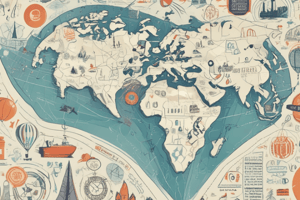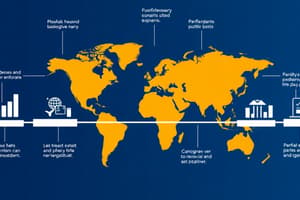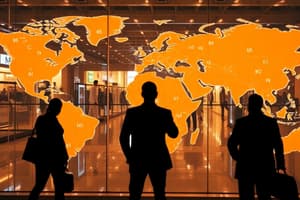Podcast
Questions and Answers
Which mode of entry is typically considered the most expensive for businesses?
Which mode of entry is typically considered the most expensive for businesses?
- Franchising
- Licensing agreements
- Exporting goods
- Investment (correct)
What type of economy is characterized by the government planning resource allocation, including production and pricing?
What type of economy is characterized by the government planning resource allocation, including production and pricing?
- Government-driven economy
- Market economy
- Mixed economy
- Command economy (correct)
When assessing potential new markets, which macroeconomic indicator is crucial for understanding price stability?
When assessing potential new markets, which macroeconomic indicator is crucial for understanding price stability?
- Industrial output
- GDP growth
- Inflation rate (correct)
- Unemployment rate
What is one common approach businesses use to mitigate currency and exchange rate risk?
What is one common approach businesses use to mitigate currency and exchange rate risk?
In a mixed economy, which statement is true regarding the role of the government?
In a mixed economy, which statement is true regarding the role of the government?
What is the primary difference between outsourcing and offshoring?
What is the primary difference between outsourcing and offshoring?
Which of the following best describes the PESTLE analysis framework?
Which of the following best describes the PESTLE analysis framework?
What is a significant disadvantage of using a multi-stage selection process in market selection?
What is a significant disadvantage of using a multi-stage selection process in market selection?
How do tariffs and quotas primarily affect international business operations?
How do tariffs and quotas primarily affect international business operations?
Which legal system relies on written legal acts and is predominantly found in most of Europe?
Which legal system relies on written legal acts and is predominantly found in most of Europe?
Flashcards
Going International
Going International
A strategy where a company expands its operations beyond its domestic market to tap into new opportunities, markets, and resources.
Outsourcing/Offshoring
Outsourcing/Offshoring
The process of transferring certain business activities, such as production, services, or research, to external providers, usually in a different country, to take advantage of lower costs, specialized skills, or other benefits.
Economies of Scale
Economies of Scale
This principle states that as production increases, the cost of producing each additional unit decreases.
Political and Trade Barriers
Political and Trade Barriers
Signup and view all the flashcards
PEST Analysis
PEST Analysis
Signup and view all the flashcards
Command economy
Command economy
Signup and view all the flashcards
Market economy
Market economy
Signup and view all the flashcards
Mixed economy
Mixed economy
Signup and view all the flashcards
Gross Domestic Product (GDP)
Gross Domestic Product (GDP)
Signup and view all the flashcards
Inflation rate
Inflation rate
Signup and view all the flashcards
Study Notes
Doing Business in a Globalized Environment
- Home markets reaching saturation compels companies to seek international opportunities.
- Imports of raw materials, cheaper labor costs, better quality, and lax protection laws are advantages in foreign markets.
- Outsourcing, primarily in non-core functions and offshoring of activities to cost-efficient locations, decrease operational expenses.
- Economies of scale are achieved with higher production volumes, lowering marginal costs and boosting productivity.
- Political and trade barriers like tariffs, taxes, quotas, and regulations can significantly impact international expansion.
Why Companies Go International
- Saturation of Home Market: Companies search for new avenues, as existing domestic markets become saturated.
- Seeking Cheaper Inputs: Companies seek cheaper raw materials, labor, or utilities in international markets compared to their home market.
- Lower Production Costs: Accessing lower-cost labor pools, and leveraging favorable social and legal frameworks in other countries can prove advantageous.
- Protectionist Measures: Reduced or absent protectionist measures in foreign markets encourage investment and trade.
- Improved Quality: Companies seek markets where they can find higher-quality raw materials and/or components.
Global Cooperation and Presence
- Strategic partnerships with foreign companies are vital for worldwide supply chains and market penetration.
- Companies establish external partnerships for supply chain efficiency and reduce operational costs.
- Private labels, where companies supply to retailers under their branded labels, offer cost savings in international markets.
International Product Life Cycle
- Products may advance through distinct stages in various marketplaces.
- Early stages of the life cycle focus on market penetration, while later stages target revenue maximization.
Market Selection
- Companies employ a multi-stage process and a scoring model to select potential international markets.
- Selecting markets that meet criteria like market size, market potential, regulatory environment or other constraints for expansion are prioritized.
PEST Analysis
- Political: Stable political systems and legal frameworks with minimal risk are prioritized.
- Economic: The stability of the economic environment including GDP indicators, inflation rates, etc. are prioritized.
- Socio-cultural: The culture of the local populace to ensure seamless operation is a crucial aspect.
- Technological: Countries with access to and advanced technology support are more attractive.
- Ecological: The level of ecological regulation is also a key consideration for companies with specific environmental concerns.
- Legal: Predictable legal frameworks and procedures with a fair judicial system for conflict resolution.
Control of Ownership
- Ownership of businesses in foreign countries is regulated by local laws and regulations.
- Foreign investment restrictions in some countries might be specific to specific sectors.
- Local laws and regulations impact the ownership structure for foreign firms.
Transfer of Profits and Taxes
- Companies have to be aware of the mechanisms to transfer profits back to their home country (and the hurdles they encounter).
Starting New Business
- Starting a business in a foreign country can be more complex compared to a home market.
- Regulations for starting a foreign company can vary significantly between countries.
Cost Reduction pressures within a globalized economy
- Pressure to minimize costs through lower production and operating costs in various locations.
- Competition often demands lower prices, which necessitates minimizing cost structures.
Local responsiveness
- Consumers have varying preferences in different markets.
- Companies must adapt their products to appeal to local tastes and preferences to be successful in these markets.
- Local responsiveness is especially critical when product customization is needed and a direct impact on revenue.
Other Key Economic Indicators
- Inflation rate measures price increases of goods and services and impacts consumer spending power.
- Unemployment and employment structures in countries offer insight into labor force trends and potential workforce costs.
- Currency exchange risk impacts profitability due to fluctuations in currency values.
Strategic Positioning and Operations
- Low-cost strategy is geared toward minimizing production costs to capitalize on the price sensitivity of markets.
- Differentiation strategy prioritizes product uniqueness or superior quality that commands premium pricing.
- Companies must have core competencies, or specific skills present in their organization, to maintain any competitive advantage.
Studying That Suits You
Use AI to generate personalized quizzes and flashcards to suit your learning preferences.
Related Documents
Description
Explore the dynamics of international business and the reasons companies expand beyond their home markets. This quiz covers aspects such as market saturation, cost advantages, and the challenges posed by political and trade barriers. Test your knowledge on how globalization reshapes business strategies.




